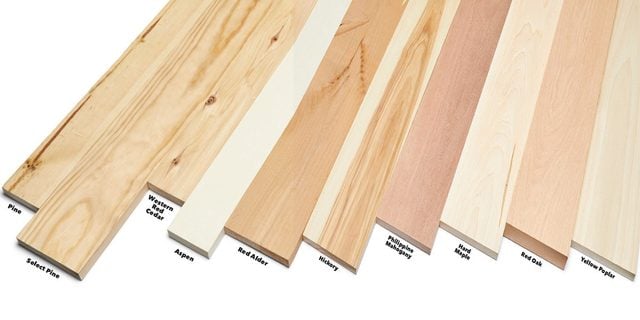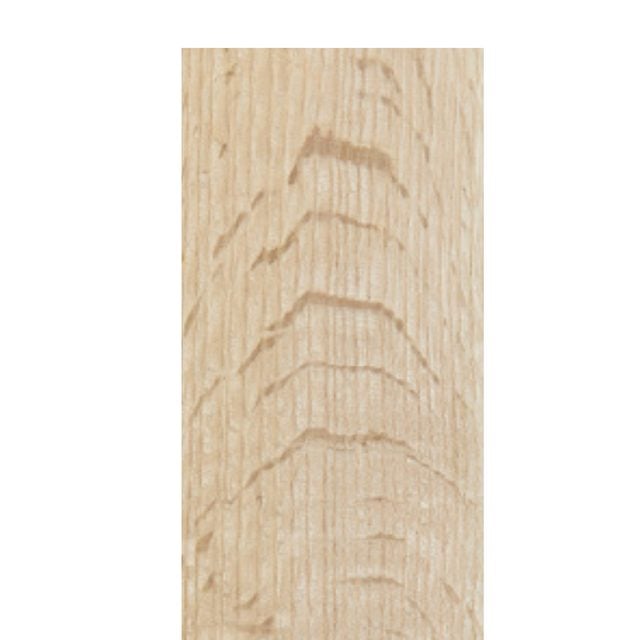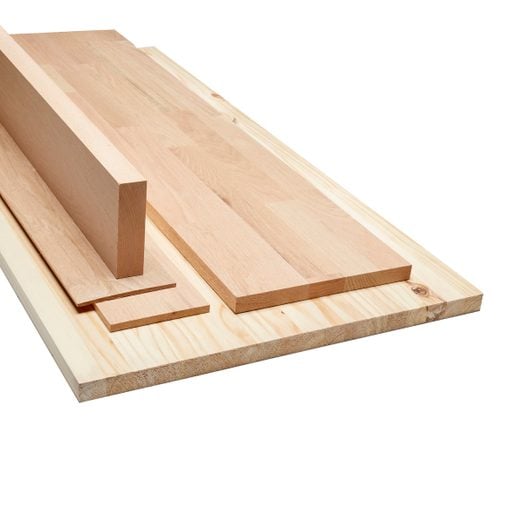How to Find the Best Home Center Lumber for Your DIY Projects
Updated: Jan. 30, 2024
Follow these tips to find exactly what you need.
Introduction
Home centers carry more lumber species (both hardwood and softwood) than they used to, but the selection is still hit-or-miss. Stores even within the same company might stock more species than another, so you’ll need to check around. Traditional lumberyards or specialty hardwood stores carry the best lumber and far more options for thicknesses and species. But with these tips, you may find everything you need at a home center.Hardwood vs. softwood

These are confusing terms, as they really don’t refer to the actual hardness of the wood. Balsa, for example, is a hardwood, but you could practically cut it with your fingernail. The term “hardwood” simply indicates that the wood comes from a deciduous tree, the type that loses its leaves in the fall. “Softwood” refers to conifers, which are generally trees with needles, like pine, spruce, fir and cedar. The vast majority of home construction is done with fast- growing softwoods.
What you’ll find at home centers

(The prices listed are for an 8-ft. 1×6.)
STANDARD PINE ($4)
Eastern white pine is the most widely used wood for home construction. Knots and resin are common. Doesn’t take stain evenly.
SELECT PINE ($10)
Same as standard pine but completely knot free. Nice for paint or natural finish.
CEDAR ($12)
Western red cedar is lightweight and rot resistant, making it popular for outdoor furniture. Knots and splits are common.
POPLAR ($13)
Yellow poplar is generally light- colored, with hues ranging from yellow to green to purple. Excellent for painted woodwork because grain doesn’t show through.
RED OAK ($17)
Red oak is the most ubiquitous cabinet wood of the last 75 years. It’s strong, durable and takes finish well.
Less common
CHERRY ($40, not shown)
Black cherry is a “medium hard” hardwood. It’s easy to work with hand or power tools and takes a finish well, turning darker as it ages. Used for high-end cabinetry and furniture.
ASPEN ($12)
Aspen is a soft, lightweight hardwood with subtle grain. It’s excellent as a base for paint or as a secondary wood (see p. 16).
RED ALDER ($21)
Red alder is a soft, lightweight hardwood. Its reddish brown color and grain texture make it resemble cherry. Stable and easy to work, it’s a good choice as either a primary or secondary wood (see p. 16).
MAHOGANY ($24)
Philippine mahogany is a soft hardwood. Typically has uniform grain and texture. The home center variety is less showy than African mahogany, but it’s a stable, easily worked primary or secondary wood.
HICKORY ($25)
Hickory, a tough hardwood with pronounced grain, is well suited for tool handles and baseball bats. It’s hard to work with hand tools but finishes beautifully.
MAPLE ($26)
Hard maple is durable and fine tex- tured. It’s a popular choice for cabinetry and furniture. Doesn’t take stain evenly.
SPECIAL ORDER
Some home centers will special-order a wide variety of species for you. We don’t recommend this unless it’s your only option. You won’t see the exact boards you’re getting until they arrive, and unless they’re somehow unusable, you won’t be able to reject them.
Project step-by-step (10)
Nonstandard boards

If you’re serious about woodworking, you’ll want a jointer and planer in your shop eventually. But if you don’t have these tools yet, know that many home centers carry hardwood thicknesses other than nominal 1-by (3/4 in. actual lumber). You can regularly find thicknesses ranging from 1/4 in. to 1-1/2 in.
If you need wide stock, you’ll also find large 1-in. or 1-1/4-in. edge-glued panels in one or two species. This is a better option than buying really wide boards, which are prone to cupping. Solid wood stair treads are another handy option.
Cut out defects

Construction lumber tends to have a lot of knots. When you’re shopping, be aware of your project’s part sizes. Often, you can buy an inexpensive board and cut around the defects.
Primary and secondary boards

If you look at antique furniture, you’ll notice that a beautiful quarter-sawn oak dresser, for example, uses expensive wood for parts that show and cheaper woods for parts that don’t. So take a page from the old masters and use the showy stuff only where it counts.
12 Tips for a Faster Home Center Trip
Buy extra

After you’ve figured out how much lumber you need for a project, add 10 to 20 percent. This allows for the inevitable mistakes, as well as trimming off split ends of boards and cutting around defects.
Use the outer edges

The way a board is cut from a log affects its stability. Quarter-sawn boards are the most stable; they don’t “move” as much with changes in humidity. Home centers don’t carry quarter-sawn lumber; it’s too expensive. But when you’re sorting through the piles, look at the end grain. Sometimes you’ll find growth rings running perpendicular to the board’s face on the outer edges. This is essentially quarter-sawn lumber. You can rip these edges free of the less stable center.
Making Sense of Lumber Dimensions
Match grain

Even though you may be buying only one species, look closely and choose matching grains and colors, especially for glue-ups. These boards are all red oak, but one of them is very different and would look hideous glued up in this panel. Even stained, their colors would be different.
Inspect boards

Sight down the edge of a board to see how flat and straight a board is. Chances are you won’t find perfect boards, only better and worse. Use the best boards for larger/longer project parts. Cut smaller parts from less perfect boards. As you cut these boards into shorter lengths, their imperfections will be less pronounced. Reject boards that twist along their length.
Buy the width you need

Hoping to save some money by ripping wide boards into narrower pieces? When you rip wide boards, internal stresses change, and they’ll likely warp a bit. This means restraightening an edge between rips. You’ll need a jointer or other straightening method for this. Instead, find the straightest boards you can that are closest to the width you need. Ripping off 1/4 in. is far less likely to cause a board to warp.
Look for gems

Home centers don’t stock premium lumber like quarter-sawn oak and curly maple. But sometimes they have it by accident, and the people who are looking for precious lumber aren’t shopping at the home center; they go to a lumberyard. So keep your eyes open. This lovely piece of quarter-sawn oak was mixed right in with the common stuff!
Lumberyards & online ordering

If you’re looking for a larger selection of hardwoods—and typically nicer lumber—go to a local lumberyard. You can find one by searching for “hardwood lumber” online. Buying lumber online is another good option. Reputable online lumber sellers provide photos, dimensions and descriptions of the actual boards you’re buying.
Working with rough-sawn boards
Serious woodworkers prefer to buy rough-sawn wood and then flatten and machine those boards down to their desired thicknesses and widths. The advantage is that the boards have warped to their final shape, so when they’re flattened, they stay perfectly flat, straight and stable. However, that calls for two specialty tools, a jointer and a planer. To learn about this process, go to familyhandyman.com and search for “how to plane rough lumber.”

